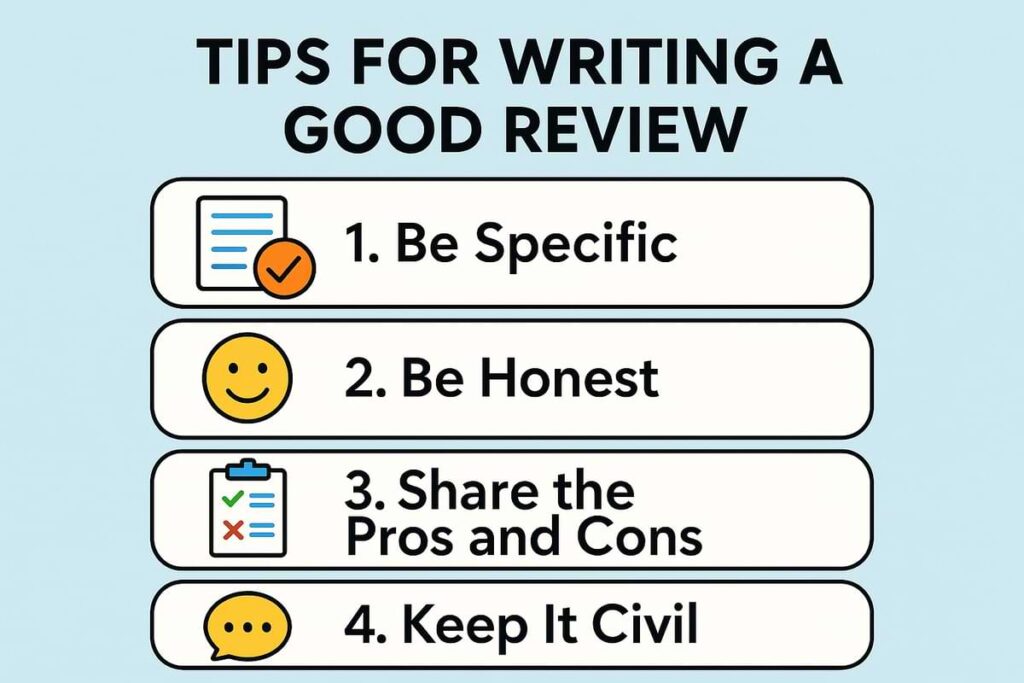In a world driven by digital opinions, good business reviews hold more power than ever. Whether shared on Google, Yelp, or social media, these reviews can shape a company’s reputation, influence buying decisions, and drive growth. But what makes a review truly “good”? It’s not just about praise or criticism—it’s about honesty, clarity, and value. A well-written review gives potential customers real insight while offering constructive feedback to the business. In this guide, we’ll explore what defines a good review and how you can write one that actually makes a difference.
What Are Good Business Reviews?
Good business reviews are honest, detailed, and thoughtfully written opinions shared by real customers based on their experiences with a company’s product or service. These reviews provide useful information to both potential buyers and the business itself.
Unlike vague or overly emotional feedback, good reviews highlight what worked, what didn’t, and why—all in a respectful and balanced tone. Whether positive or negative, a good review is focused on facts, clarity, and helpful insights.
Purpose Of Good Business Reviews
Good business reviews serve as a powerful tool for both customers and businesses. Their main purpose is to create a transparent, trustworthy, and informative environment that helps people make smarter decisions and encourages businesses to grow and improve.
✅ 1. Help Potential Customers Make Informed Decisions
Well-written reviews provide real experiences that guide others in choosing the right product or service, reducing the risk of disappointment.
✅ 2. Build Trust and Credibility
Consistent, genuine feedback builds a business’s reputation and helps customers trust brands they’ve never interacted with before.
✅ 3. Provide Constructive Feedback to Businesses
Reviews highlight what a business is doing well and where it needs improvement, giving owners valuable insight from a customer’s point of view.
✅ 4. Encourage Higher Service Standards
Knowing customers will leave public feedback encourages businesses to maintain better quality, customer support, and professionalism.
✅ 5. Support Local SEO and Online Visibility
Fresh, positive reviews improve search engine rankings and help businesses appear in local search results and Google Maps listings.
✅ 6. Promote Two-Way Engagement
Reviews open up a channel for businesses to interact with customers through replies, showing accountability and care.
Key Elements of a Good Review
A well-written business review is more than just a star rating — it’s a helpful, honest, and structured summary of a customer’s experience. Here are the essential elements that make a review truly valuable:
1. Clarity and Simplicity
Use clear, easy-to-understand language. Avoid jargon or overly emotional language.
2. Honesty
Share your genuine experience — whether it’s positive, negative, or mixed. Authenticity builds trust.
3. Specific Details
Mention what product or service you used, the date of your visit, staff interaction, pricing, delivery time, etc.
4. Balanced Perspective
Try to include both pros and cons if possible. A fair review is more trustworthy than one-sided praise or criticism.
5. Helpful Tone
Write your review to help others. Focus on what others should know before they choose the same business.
6. Respectful Language
Stay polite—even in negative reviews. Avoid personal attacks or offensive language.
7. Mention of Key Highlights
Point out specific moments that made your experience better or worse (e.g., “quick service,” “rude staff,” “delicious food”).
8. Star Rating (if applicable)
A star rating helps summarize your experience quickly and is often required by platforms like Google, Yelp, or TripAdvisor.
Tips For Writing a Good Review

Writing a business review may seem simple, but crafting a useful, balanced, and honest review requires thought and structure. A good review not only reflects your experience—it helps others make better choices and gives businesses insight into what they’re doing well (or not so well).
Here are some detailed tips to help you write a great business review:
✅ 1. Start With a Summary Statement
Begin your review with a quick overview of your experience. This summary sets the tone and tells readers right away whether the experience was good, bad, or mixed.
Example: “I had a pleasant experience at Urban Roots Café. The atmosphere was warm, and the staff was very attentive.”
✅ 2. Be Honest and Authentic
Always be truthful. Whether the experience was amazing or disappointing, write exactly how you felt—but stay grounded. Readers trust reviews that feel genuine, not exaggerated or fake.
🔹 Avoid: “This is the best place in the world!”
✅ Use: “The food was tasty and well-presented, although slightly overpriced.”
✅ 3. Include Specific Details
Details matter. Mention what product or service you used, when you visited, how you were treated, and anything unique about the experience. The more specific, the more helpful your review becomes.
Example: “I ordered the paneer tikka roll with extra chutney. It arrived in 25 minutes, hot and well-packed. The flavor was excellent, though a bit spicy for my taste.”
✅ 4. Keep It Balanced
A good review isn’t just all praise or all criticism—it’s fair. If you had a great experience but noticed one small issue, mention it. This adds credibility and helps others form a realistic picture.
Example: “The food was fantastic, but the seating area was a bit cramped during peak hours.”
✅ 5. Use a Respectful Tone
Stay calm and polite, especially if your experience was negative. Personal attacks or rude language reduce the value of your review and may even get it removed from the platform.
❌ Avoid: “The staff was useless and lazy.”
✅ Use: “The service was slower than expected, and staff seemed overwhelmed.”
✅ 6. Mention Key Features
Highlight important aspects like product quality, customer service, speed of delivery, cleanliness, value for money, ambiance, or packaging. This helps readers compare similar businesses.
Example: “What stood out was their eco-friendly packaging and quick checkout process.”
✅ 7. Add Visual Proof (If Possible)
Photos of the product, restaurant, packaging, or service area make your review more trustworthy. A picture adds credibility and helps others see what to expect.
📷 Consider uploading clear photos of:
-
Meals
-
Delivery packaging
-
Receipts
-
Product condition
✅ 8. Use Proper Grammar and Structure
A well-structured review is easy to read. Break long thoughts into paragraphs, use punctuation, and avoid typing in all caps. Even a brief review benefits from clean writing.
✅ 9. Give a Clear Recommendation
Close your review by stating whether you would recommend the business to others. This helps readers quickly decide if it’s worth their time or money.
Example: “Overall, I’d recommend this salon for its service quality, but be sure to book in advance to avoid long waits.”
✅ 10. Follow Platform Guidelines
Each review platform (Google, Yelp, Amazon, etc.) has its own rules. Avoid including personal information, promotional links, or inappropriate content that might get your review removed.
Examples of a Good Review
✅ 1. Restaurant Review
⭐⭐⭐⭐⭐
“I visited The Olive Bistro last weekend and was genuinely impressed. The ambiance was cozy, and the staff greeted us warmly. I ordered the penne arrabbiata, which was served fresh and flavorful within 15 minutes. The only downside was a bit of background noise during peak hours. Still, I’d highly recommend it for a casual date night or family dinner.”
✅ 2. Online Store Review
⭐⭐⭐⭐☆
“Ordered a wireless keyboard from TechKart, and it arrived in just 3 days, securely packed. The product matched the description and works smoothly. The only issue was that the tracking page wasn’t updated in real time. Overall, a reliable online store with quality products.”
✅ 3. Service-Based Business (Salon)
⭐⭐⭐⭐⭐
“Booked a haircut at Luxe Salon for the first time. The stylist listened carefully and delivered exactly what I wanted. The place was clean, and they followed hygiene protocols well. Prices were reasonable for the quality of service. Definitely going back!”
✅ 4. Café or Coffee Shop
⭐⭐⭐⭐☆
“Nice little spot for coffee lovers! The cappuccino was rich and creamy, and the almond croissant was fresh. The service was quick, though seating is limited during rush hours. Great for takeaway or solo work sessions.”
✅ 5. Mobile App Review
⭐⭐⭐⭐☆
“The fitness tracking app is very user-friendly and accurate. I like the weekly progress reports and goal-setting features. It occasionally lags when syncing with my smartwatch, but overall, it’s one of the best apps I’ve used for daily health tracking.”
✅ 6. Doctor or Clinic Review
⭐⭐⭐⭐⭐
“Dr. Mehra was professional, patient, and attentive to my concerns. The clinic was clean, well-organized, and the appointment system was smooth. I didn’t have to wait long, and the follow-up instructions were clear. Highly recommended for general consultations.”
Why Good Reviews Matter?
In today’s digital-first world, good business reviews are more than just customer feedback—they’re powerful tools that shape trust, influence buying decisions, and drive growth. Whether it’s a local store, an online brand, or a service provider, reviews directly impact a business’s visibility, reputation, and success.
✅ 1. They Influence Customer Decisions
Before buying, most customers read reviews to assess the quality, reliability, and credibility of a business. A series of good reviews can turn a curious visitor into a loyal customer.
✅ 2. They Build Trust and Credibility
Positive, authentic reviews act like digital word-of-mouth. When people see consistent praise or constructive feedback, they’re more likely to trust the business—even if they’ve never heard of it before.
✅ 3. They Improve Search Visibility (SEO)
Search engines like Google reward businesses with frequent, high-quality reviews by ranking them higher in local search results. This means more visibility, traffic, and leads.
✅ 4. They Offer Valuable Feedback to Businesses
Good reviews often include helpful insights—what customers liked, what needs improvement, and what stood out. This helps businesses improve their products, services, and customer experience.
✅ 5. They Encourage Better Customer Service
Knowing that customers may share their experiences publicly motivates businesses to maintain high standards in every interaction.
✅ 6. They Create a Competitive Edge
In a crowded market, businesses with strong reviews stand out. Whether it’s a 5-star rating on Google or a glowing testimonial on Yelp, good reviews set you apart from competitors.
✅ 7. They Boost Brand Loyalty and Engagement
Satisfied customers who leave positive reviews often feel more connected to the brand, increasing their chances of returning and recommending it to others.
What to Avoid in Reviews
Writing a good review means being honest and constructive—but it also means avoiding certain pitfalls that can reduce the impact of your feedback or even get your review removed. Here’s what to steer clear of when posting business reviews:
❌ 1. Vague or Generic Comments
Avoid writing reviews like “It was good” or “I didn’t like it” without any details. These don’t help others understand your experience.
❌ 2. Personal Attacks or Insults
Refrain from name-calling, offensive language, or attacking employees personally. Keep your feedback focused on the service or product, not individuals.
❌ 3. Exaggerations or False Information
Don’t exaggerate positives or negatives. Fake or misleading reviews harm credibility and may violate platform policies.
❌ 4. Off-Topic Content
Stay focused on the product, service, or business experience. Avoid unrelated political views, promotions, or personal stories.
❌ 5. Excessive Use of Profanity
Strong language may be censored or cause your review to be removed. Keep your tone respectful and professional.
❌ 6. Spam or Promotional Content
Don’t use reviews to advertise other businesses or products. Platforms usually prohibit promotional spam.
❌ 7. Posting Multiple Reviews for the Same Experience
Stick to one honest review per experience to avoid appearing spammy or dishonest.
❌ 8. Ignoring Platform Guidelines
Each review site has rules—like word limits, content restrictions, or conflict of interest policies. Violating these may get your review taken down.
Final Thought
Writing a good business review is a powerful way to share your experience, help others make informed decisions, and support businesses in their growth journey. Honest, detailed, and respectful reviews create a trustworthy community where customers and businesses thrive together. Whether you’re praising exceptional service or offering constructive feedback, your words hold value. So next time you engage with a business, take a moment to share your insights thoughtfully — it makes a difference.
Frequently Asked Questions
1. What makes a business review helpful?
A helpful review is honest, specific, balanced, and respectful. It provides clear details about the customer’s experience, highlighting both positives and areas for improvement.
2. How long should a good business review be?
There’s no fixed length, but a good review typically ranges from 100 to 300 words. Enough detail should be included to help others understand your experience without being too lengthy.
3. Can I write a negative review?
Yes, negative reviews are important when they’re honest and constructive. Avoid personal attacks and focus on facts and specific experiences.
4. Should I include photos in my review?
If possible, yes! Photos add credibility and help other customers see the actual product or service.
5. How often can I post reviews about the same business?
Generally, post one review per unique experience. Multiple reviews for the same visit or purchase may be considered spam.
6. Are star ratings important?
Yes, star ratings provide a quick summary of your experience and help other customers compare businesses easily.
7. Can businesses respond to reviews?
Yes, many platforms allow businesses to reply. This helps clarify issues and shows that the business values customer feedback.
8. What should I avoid when writing a review?
Avoid vague comments, personal attacks, fake information, off-topic content, and promotional spam. Always follow the platform’s guidelines.
Related Posts























